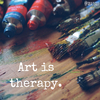Making Art Work: Social Media and the Artist (Part Four)
“Welcome to the Making Art Work Series! Through this accumulating and growing collection of resource articles, we hope to give insight and suggestions to artists in their journey to becoming their most successful creative selves!”
Part Four: Kinds of content
Welcome to the latest installment in our "Social Media and the Artist" series. After discussing algorithms, strategy, and distribution, it is a great time to address what kinds of content an artist can make. What type of content can a creative produce and distribute? As always, let's go through some options you have at your disposal.
Types of Content: This is not an easy topic to cover because art content spans many categories. For the sake of brevity and accuracy, we will be reviewing different kinds of content, their target audience, and examples of what successful content can be.
Progression-focused Content (Timelapse, Music Video, Stop Motion, Photo doc, etc.)
Documenting the process of a piece of artwork has been a mainstay in content creation. Whether it is via photographs, video, or live streaming, there is a significant amount of interest in watching someone start and finish a piece of art. This interest helps provide insight into the process for both artists and audience members alike and helps invite viewers to invest and join in on the creative process. This kind of content can be long-form, created with live streaming on twitch or blog-like communications, or can be short-form using video editing to create quick timelapse clips or photo breakdowns.
For a couple of examples of this kind of work:
https://www.youtube.com/watch?v=PbyqhQubJbc
Showcased/Finished work (Photo Galleries, Portfolio Sites, Blogs, Gallery Vlogs, etc.)
Displaying finished work is the most traditional and straightforward approach, and is arguably the easiest. However, to capitalize on the appeal of showing completed work, it may require a much more polished set of photographs or videos. One can show this kind of content via photo album, unveiling video, or live stream. Be sure to have well-lit, well-photographed pictures. Consider the photos of the finished work just as important as the work itself. It is indeed a significant part of the presentation of the art to an online audience.
Here is an example of an artist that showcases their work in a professional, traditional, and compelling way:
Education-Based (How-to, Instructional, Paint along, etc.)
If you are comfortable showing your work in a way that people can learn from it, you can follow in the footsteps of such great public art instructors such as Bob Ross, Bruce Blitz, and Susan Scheewe. You can produce content that helps show a viewer how to make something on their own, or show an artist how to follow along with you in real-time. There are also a large number of artists who produce content on youtube that provided education and discussion.
Here is an excellent example of a personality-based instructional product made by James Gurney:
https://www.youtube.com/watch?v=yyIOtN339q4
Entertainment-Based (Podcasting, Live-streaming, Personality-based)
This type of content is very prevalent on sites like Youtube, Instagram, TikTok, and Snapchat. The content is less about the education but more on the compelling personality of the artist. Content like this is accessible among younger artists, where sharing your work is secondary to the presenter. These can be videos that follow online trends, art challenges, and experimental creative projects.
Here is a fantastic example of an entertainment-based content by artist Ten Hun:
https://www.youtube.com/watch?v=yK-4TbusVGQ
Discussion-Based (Podcasting, Vlogging/Blogging)
Radio has evolved into podcasting, vlogging, and the advent of the personally-created talk show. With so many voices able to broadcast, this industry is booming with unique points of view and topics to discuss. These kinds of content can be longer and can span a broad spectrum of material.
Here is an excellent example of discussion-based content from Proko:
https://www.youtube.com/watch?v=BWBeGTWGF2c
Hopefully, this is helpful to you! Now that you have some examples of what kind of content to make, you can apply your creativity and inspiration and develop your own wholly unique collection of material for people to see!
Did we miss anything? Let us know in the comments!







